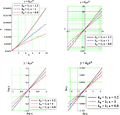Allometry facts for kids
Allometry is a science that looks at how the size of an animal's body parts relates to its overall body size. It also studies how different body parts grow at different rates. For example, as an animal gets bigger, some parts might grow faster than others.
This idea helps us understand how animals change their body shapes as they grow or as species evolve over time. These changes are often helpful for the animal to survive. For instance, an animal's intestine might need to grow faster than other parts to absorb enough food as the animal gets larger.
Allometry also helps explain how the general body shape of a group of animals changes as they evolve. Sometimes, the timing of development changes in an evolutionary group. This trend is called heterochrony.
Scientists like Otto Snell (in 1892), D'Arcy Thompson (in 1917), and Julian Huxley (in 1932) first described allometry. They often used a special math formula called a power law to describe these relationships:
This formula helps show how two measured things are connected.
How Size Affects Body Design
In 1926, a scientist named J.B.S. Haldane wrote an essay called On being the right size. He explained how an animal's size often decides what kind of body parts it needs.
For example, insects are very small. They don't need blood to carry oxygen around their bodies. The small amount of oxygen their cells need can just spread through their bodies from the air. But bigger animals need complex systems to pump and deliver oxygen to all their cells.
The Square-Cube Law
Many of Haldane's examples use something called the square-cube law. This law says that if you double an animal's length, its surface area will become four times bigger (doubled squared), but its weight will become eight times bigger (doubled cubed).
This difference in how surface area and weight change with size causes animals to have different body shapes as they evolve to be larger or smaller. If an animal gets much bigger, its physical shape must change a lot. Otherwise, it might become too weak to support its own weight.
Images for kids
-
Allometric relations often look like straight lines when plotted on special double-logarithmic graphs.
See also
 In Spanish: Alometría para niños
In Spanish: Alometría para niños




